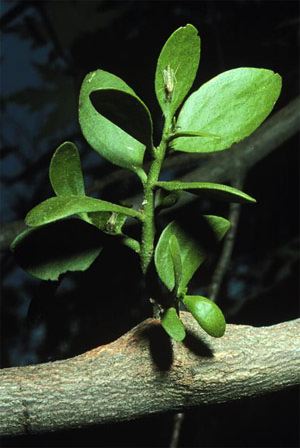 We have an abundance of mistletoe growing in the oak trees on our property, so when I saw tiny bags of the plant for sale in our local coop, I balked at the price ($4.95). I think I should go in the mistletoe business! I don’t have much affinity for this plant, as it is a parasite and smothers some of my trees; however, my herbalist friend has taught me new respect for mistletoe when she made a bough with my daughter to hang over our door.
We have an abundance of mistletoe growing in the oak trees on our property, so when I saw tiny bags of the plant for sale in our local coop, I balked at the price ($4.95). I think I should go in the mistletoe business! I don’t have much affinity for this plant, as it is a parasite and smothers some of my trees; however, my herbalist friend has taught me new respect for mistletoe when she made a bough with my daughter to hang over our door.
From kissing under mistletoe to placing a sprig in a baby’s crib, the legends of mistletoe are great. According to Candlegrove.com:
Mistletoe was used by the Druid priesthood in a very special ceremony held around this time…five days after the New Moon following winter solstice, to be precise. The Druid priests would cut mistletoe from a holy oak tree with a golden sickle. The branches had to be caught before they touched the ground.
Celts believed this parasitic plant held the soul of the host tree.
The priest then divided the branches into many sprigs and distributed them to the people, who hung them over doorways as protection against thunder, lightning and other evils. The folklore, and the magical powers of this plant, blossomed over the centuries A sprig placed in a baby’s cradle would protect the child from faeries. Giving a sprig to the first cow calving after New Year would protect the entire herd. And so forth.
But what about the holiday tradition of kissing under mistletoe? This legend dates back to Norse mythology. Frigga, the goddess of love and beauty, wished to protect her son Balder.
So she went through the world, securing promises from everything that sprang from the four elements–fire, water, air, and earth–that they would not harm her beloved Balder.
Leave it to Loki, a sly, evil spirit, to find the loophole. The loophole was mistletoe. He made an arrow from its wood. To make the prank even nastier, he took the arrow to Hoder, Balder’s brother, who was blind. Guiding Holder’s hand, Loki directed the arrow at Balder’s heart, and he fell dead.
Frigga’s tears became the mistletoe’s white berries. In the version of the story with a happy ending, Balder is restored to life, and Frigga is so grateful that she reverses the reputation of the offending plant–making it a symbol of love and promising to bestow a kiss upon anyone who passes under it.
Did you know that mistletoe has medicinal properties? Small amounts of mistletoe have been used to effectively treat epilepsy, convulsive nervous disorders, heart disease, and urinary disorders. This powerful plant should be used with caution and only under the care of an experienced herbalist or doctor. In fact, many poison control centers issue holiday warnings that mistletoe is poisonous; however, it is not lethal. According to the New York Times,
But in studies of hundreds of cases of accidental ingestion over the years, there were no fatalities and only a handful of severe reactions. One study published in 1996 looked at 92 cases of mistletoe ingestion and found that only a small fraction of patients showed any symptoms. Eight of 10 people who consumed five or more berries had no symptoms, and 3 of the 11 people who consumed only leaves had upset stomachs.
It appears its lethal reputation is yet another mistletoe legend.
Since my friend made that first mistletoe bough with my daughter, we have begun a new holiday tradition in our family. In celebration of the Solstice and birth of a new year, we hang a fresh bough of mistletoe above our doorway. Whether or not the plant protects our home from evil spirits, at least we have removed one parasite from our oak tree.
Image courtesy of Hilton Pond.
Leave a Reply